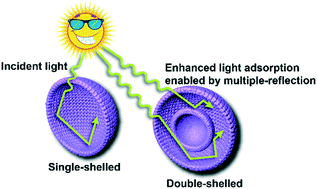当前位置:
X-MOL 学术
›
CrystEngComm
›
论文详情
Our official English website, www.x-mol.net, welcomes your
feedback! (Note: you will need to create a separate account there.)
Morphology-preserved transformation of CdS hollow structures toward photocatalytic H2 evolution
CrystEngComm ( IF 2.6 ) Pub Date : 2020/01/06 , DOI: 10.1039/c9ce01494b Ye Liu 1, 2, 3, 4, 5 , Cheng Huang 1, 2, 3, 4, 5 , Tengfei Zhou 6, 7, 8, 9, 10 , Juncheng Hu 1, 2, 3, 4, 5
CrystEngComm ( IF 2.6 ) Pub Date : 2020/01/06 , DOI: 10.1039/c9ce01494b Ye Liu 1, 2, 3, 4, 5 , Cheng Huang 1, 2, 3, 4, 5 , Tengfei Zhou 6, 7, 8, 9, 10 , Juncheng Hu 1, 2, 3, 4, 5
Affiliation

|
Hollow-structured nanomaterials with complex interiors have drawn a great deal of attention due to their unique properties in various fields. Herein, we present the controllable synthesis of CdS hollow microspheres for photocatalytic H2 production. The quasi-emulsion microdroplets formed by the glycerol–isopropanol mixed solution serve as the soft templates of the solid Cd–glycerol precursors, which offer a scaffold for the subsequent topological transformation of the hollow-structured CdS. In virtue of this, single-shelled and double-shelled CdS hollow microspheres could be attained by simply controlling the reaction time. Experimental results reveal that the double-shelled hollow structure endowed the CdS photocatalyst with better H2 production capability compared to the single-shelled analogue. This work could offer a new approach toward the synthesis of complex hollow-structured nanomaterials with enhanced photoactivities.
中文翻译:

形态保留的CdS空心结构向光催化H2释放的转变
具有复杂内部结构的中空结构纳米材料因其在各个领域的独特性能而备受关注。在本文中,我们介绍了可控制的CdS中空微球的合成,用于光催化H 2的生产。由甘油-异丙醇混合溶液形成的准乳液微滴用作固体Cd-甘油前体的软模板,为后续的中空结构CdS拓扑转换提供了支架。因此,可以通过简单地控制反应时间来获得单壳和双壳CdS空心微球。实验结果表明,双壳中空结构赋予CdS光催化剂更好的H 2与单壳模拟物相比具有更高的生产能力。这项工作可以为合成具有增强的光活性的复杂的中空结构纳米材料提供一种新方法。
更新日期:2020-02-13
中文翻译:

形态保留的CdS空心结构向光催化H2释放的转变
具有复杂内部结构的中空结构纳米材料因其在各个领域的独特性能而备受关注。在本文中,我们介绍了可控制的CdS中空微球的合成,用于光催化H 2的生产。由甘油-异丙醇混合溶液形成的准乳液微滴用作固体Cd-甘油前体的软模板,为后续的中空结构CdS拓扑转换提供了支架。因此,可以通过简单地控制反应时间来获得单壳和双壳CdS空心微球。实验结果表明,双壳中空结构赋予CdS光催化剂更好的H 2与单壳模拟物相比具有更高的生产能力。这项工作可以为合成具有增强的光活性的复杂的中空结构纳米材料提供一种新方法。











































 京公网安备 11010802027423号
京公网安备 11010802027423号